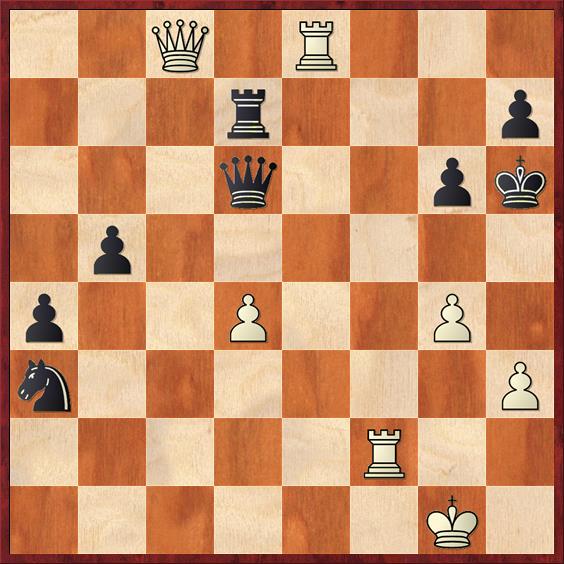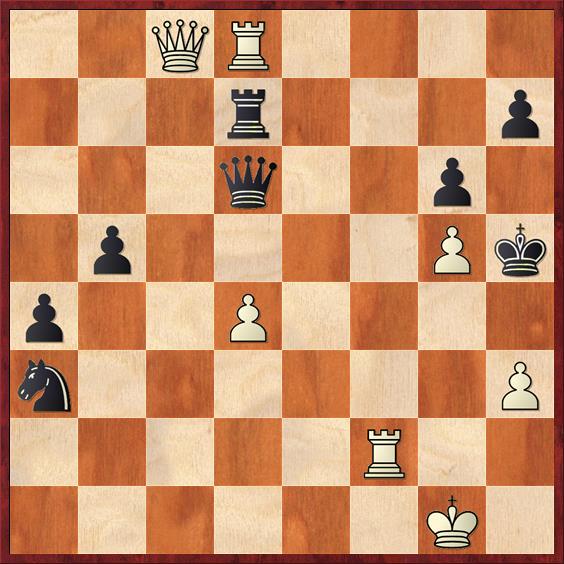The title describes me, Gjon Feinstein and Mike Splane, although in truth Mike should get credit for being only half blind.
Yesterday afternoon we got together for some rare weekday chess (usually we meet on weekends), and Mike wanted to show Gjon the two challenge positions from my last blog post, which Gjon had not read. Gjon had some great thoughts about the first position. (The move he immediately focused on was 20. d4, which is probably at least as good if not better than the move I played, 20. e5.)
But it was the second position where the three national masters acted more like the three blind mice. Let me remind you of the position:
 Position after 45. … Kh6. White to move.
Position after 45. … Kh6. White to move.
FEN: 2Q1R3/3r3p/3q2pk/1p6/p2P2P1/n6P/5R2/6K1 w – – 0 46
This was from a game I played against Shredder, where I was White. I played 46. g5+! Kh5 (if 46. … Kxg5? 47. Qc1+! sets up either Re5+ or Rf4+ next move). My next move was the slightly harder-to-find 47. Qc3! To give Gjon a chance to find it himself, I started to explain my thinking: “In a position like this you’ve got to see where the checkmates are.” And at that moment, as if on cue, Mike reached over and played 47. Rd8!?
 Position after 47. Rd8 (analysis). Black to move.
Position after 47. Rd8 (analysis). Black to move.
FEN: 2QR4/3r3p/3q2p1/1p4Pk/p2P4/n6P/5R2/6K1 b – – 0 47
Well, now. I think I must have sat there with my mouth agape for half a minute. A fly could have buzzed in and out of my mouth and I wouldn’t have even noticed.
Of course, point number one is that the rook can’t be taken: 47. … Rxd8?? 48. Qg4 mate! As I had just said, you have to visualize the checkmates!
But Mike’s move is deeper than that, as we found out when we started playing through the variations. The only real option for Black is 47. … Qg3+ 48. Rg2. And then we looked at several possibilities. If 47. … Qe1+ 48. Kh2 or 47. … Qe3+ 48. Kh1 Qe1+ 49. Kh2, Black runs out of checks and has to give up the rook. Perhaps the most amazing variation is 47. … Qe3+ 48. Kh1 Rxd4, which seems to defend the mating square. But then White has another mating idea: 49. Qc7! (It’s also possible to trade rooks and play Qf8, but this move introduces a theme we’ll come back to later.) This threatens Qxh7 mate and also keeps the important e5 square under observation. After 49. … h6 50. Qg7 Black cannot stop Qxh6 mate. He has tons of threats but everything he can try is a tempo too slow. Once again, the key is to see where the checkmates are.
Gjon and I finally had to agree that 47. Rd8 looked like a beautiful winning idea, certainly prettier than my 47. Qc3 (which worked, but just barely and only after exhaustive and exhausting analysis).
However, one little corner of my mind still felt skeptical. The reason was that I had gone over this game carefully with Rybka, and I didn’t remember seeing 47. Rd8 in Rybka’s analysis. Surely such a strong move would have showed up at the top of its list.
Sure enough, when I got home and put Mike’s move on the computer, it found a loophole. Black can in fact draw from the second position. Can you figure out how?
While you’re thinking about it, let me just say that this fact in no way detracts from the ingenuity of Mike’s move 47. Rd8. In fact, Gjon has said more than once that one of the strengths of Mike’s game is that he comes up with ideas that nobody else sees. That was certainly the case here. At some point in my hour-long timeout, I should have spotted this move, but I didn’t. In a way I’m lucky, because if I had spotted it I almost certainly would have played it, and then I would only have drawn the game! Instead I played the less spectacular move and won.
Have you found the variation that none of the Three Blind Mice could see? It’s pretty amazing in its own right — because now Black has to be very creative. The first move was right: 47. … Qg3+ 48. Rg2. But now Black has to realize that his queen defending against the checkmate on g4. Therefore Black can play 48. … Rxd8! And White’s queen is hanging, too!
But that’s not all, folks! First, if 49. Qxd8 Qe3+ 50. Rf2? Qxg5+ gets Black out into a winning endgame, so White has to play 51. Kh1 Qc1+ 52. Rg1 Qe3! And in spite of his tempo gain, White cannot make progress because he has to defend the checkmate on h3. (Previously Black could never take this pawn because of Rh2, but now he’s threatening it for real.) After 53. Qd7 Qf3+ Black’s queen has reached its ideal position on the f-file and White cannot escape the checks.
But that’s still not all, folks! Instead of taking on d8, White can double down on his rook sacrifice and play 49. Qb7!?, again threatening mate on h7. Black has to defend with: 49. … h6 or 49. … Rh8. (It doesn’t matter which he plays — both draw in the same way.) Then 50. Qg7 seems to be lights out — but it’s not! Black has the miraculous defense 50. … Qc1+ 51. Rg1 Qc6+ and now if 52. Kh2?? Qd6+! followed by 53. … Qf8 and Black is winning! Instead White has to play 52. Rg2 and allow a repetition with 52. … Qc1+.
So, why couldn’t the Three Blind Mice find this defense? Well, first of all, it’s darned tricky. The incredibly precise maneuver by Black’s queen, … Qg3-e3-c1-c6-d6-f8, was hard to anticipate. But that doesn’t excuse us, because we didn’t even find the first move of the combination, 48. … Rxd8!
I think that there are two psychological reasons. First, because White’s rook was taboo on move 47 we mistakenly thought that it was still taboo on move 48. A good rule of thumb: If your opponent plays a sacrifice that you decline, but the sacrifice remains on offer, don’t forget to keep checking whether it’s still sound. The second reason is that we had a gut reaction: our queen is en prise, so we must move our queen. Even for masters, it is very difficult to overcome these almost instinctive reactions. I think it’s one of the hardest things in chess to do: Question assumptions — especially your own.
I still can’t stop shaking my head over this position. The move that ought to win, 47. Rd8, allows Black a miracle draw, while a move that seems much less precise, 47. Qc3, gives White a miracle win. What a crazy game chess is.



{ 1 comment… read it below or add one }
Thanks for the compliment “one of the strengths of Mike’s game is that he comes up with ideas that nobody else sees. ”
In the spirit of that comment, after 47. Rd8 Qg3+ 48. Rg2 Rd8 I came up with 49 Qe6 as another possible candidate move. I think with best play it transposes back into the drawing line you showed against 49. Qb7
49. Qe6 Qf3 50 Qe7 Rh8 51. Qg7 Qe3+ 52. Kh1 Qc1+ 53. Rg2 Qc6+ 54. Kh2 Qd6+ 55. Rg3 Qf8.